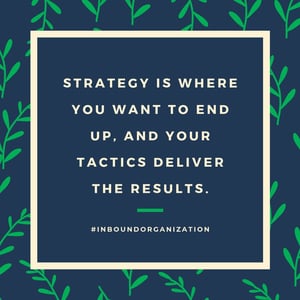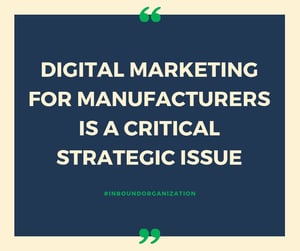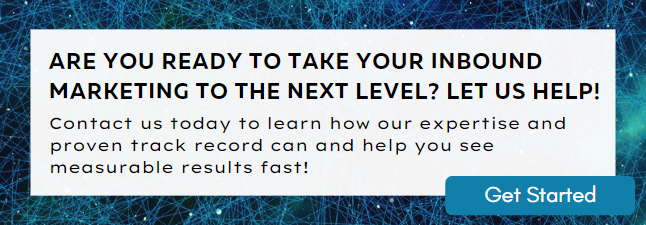Posted by Todd Hockenberry ● Dec 27, 2023
Digital Marketing Strategy for Manufacturers
Simply put, a digital marketing strategy for manufacturers determines your ability to connect with modern buyers. ALL buyers use the Internet to answer questions, seek alternatives, and evaluate vendor options.

Why do you need a digital marketing strategy if you are a manufacturer?
- Upstart competitors are winning more attention online than your company, even though you have been around longer and have better products.
- Digital ads are eating up more budget while generating fewer high-quality leads
- Trade shows are never going to be what they were two+ years ago.
- Print magazines in your trade industry rely on vanity metrics like impressions to convince you they are still relevant.
- Your salespeople struggle to get prospects to answer the phone or reply to voicemails.
- Customers are more likely to switch suppliers now than ever before.
- A digital marketing strategy for manufacturers helps you decide what you will do today to arrive where you want to be tomorrow.
Not sure you need a digital marketing strategy?
- Do you want to rank number one in the search for your key topics and not just for your company name?
- Do you want your ideal buyers to find you online when they search for topics related to your business?
- Do you want your content to be viewed as helpful and an authoritative resource for the key prospects of your business?
- Do you want to engage with influencers, potential partners, employment candidates, and prospects online through social media?
- Do you see digital marketing as a way to grow your business or as a cost to be endured?
Or does your digital manufacturing strategy boil down to adding pages to your site when you have product updates, posting self-indulgent information on LinkedIn occasionally, and sending boring emails to your list?
If you focus on the tactical side of B2B digital marketing, you probably do not see much in the results. You probably think of your website and digital marketing as a cost, not an investment.
If you look at digital marketing strategy as something your agency handles or the marketing associate figures out, you will be left behind.
I just talked to a prospect that aims to drive $2M+ in new revenue by using digital marketing to connect to a new market. They know the market exists and have a differentiated and effective product in this niche.
But when I proposed a targeted topic, SEO-based, content development, persona-focused, digital marketing strategy that was around $60,000 for a year, the owner of the business said, 'That is a lot of money for a website.'
At this point, I am not sure he will change his mindset (though I am pretty convincing and have the case studies to prove we will succeed) because he sees digital marketing as a cost, not a long-term investment. If they ever hope to stand out online, they must commit to a digital marketing strategy to create content and optimize and promote it.
Otherwise, they will rely on outbound tactics like cold calls, list buying, and paid ads which may or may not be successful - but it will certainly be expensive.
Make no mistake; this is a strategic decision, not just a one-time tactical marketing campaign.
Most manufacturers face this same decision - do we invest and commit to a long-term digital marketing strategy, or do we bounce from campaign to tactical campaign and hope we hit a home run?
Why do you need a digital marketing strategy?
Because your prospects and customers want you to have one.
Please absorb that thought.
You owe it to your prospects to be available to them where, when, and how they want to be helped. That means online. No exceptions.
Your prospects want you to be online, share helpful content, and be available when they want the information and solutions they seek.
I shouldn't even have to say this, but over 95% of B2B buying journeys start with an Internet search.
And we all know much of the buying process is over before they ever talk to your sales team (up to 70% of the process in many B2B cases). Search for this data and see the many sources that confirm these behavioral changes for B2B buyers.
So how do you combat these buyer-driven changes?
Develop a digital marketing strategy to reach your ideal target prospects earlier in the process and become the resource for helping them solve the problems you solve so well.
So we agree that digital marketing for manufacturers is a critical strategic issue. So now what, where do you start?
Value
You must clearly define why you deliver value to your ideal target customer, how you communicate that promise, and what needs to happen to facilitate the buying process online.
I ask our prospects this question, and too often, I hear vague answers like we are great at service, our quality is the best, or we have great designs. These things in and of themselves are not valuable to your customers.
Unless you specify how their world gets better, their problems go away, or their goals are achieved, you are not adding value by saying quality, service, or design.
Many of your customers want the sales process to add value to them; does yours? Could you say that your sales process is a competitive advantage because your team pushed prospects to look at their world in a new way and see how they might take another path to success?
Or does your team talk features and ask lame discovery questions like what keeps you up at night? Is your sales team to be tolerated by prospects, or do they add value in each interaction?
You can't focus your digital marketing strategy unless you are very clear on the value you add and why your prospects and customers consider it valuable in the first place.
Targeting Your Ideal Customer
Define your ideal client by answering these questions:
- Who do you help the most?
- What makes you different from their perspective – what do they value that you do?
- Which products and customers do you make the most profit from?
- What are the common behaviors of your most profitable client?
- Who do you and your team get the most passionate about?
- Who are your most loyal customers? What do they have in common?
- What customers are evangelists of your company and why?
- Which customers regularly refer you to other high-value prospects?
- Which buyers will tell you why you were chosen and how they went through the decision-making process?
If your prospects can’t differentiate between you and your competitors -and your team can't make the case that you are different and better - buyers will select a company using the one criterion they can compare – price.
Before executing digital marketing tactics, you must be very specific about your target market and who you want to work with. You may focus on a particular technology, industry, and product or on solving a specific unique problem.
By identifying your ideal buyer persona, you can create messaging and content that directly addresses their issues, pain, and problems. Your messaging and content will now be helpful in their context about what they need to know - otherwise, you are stuck just pitching a product.
If you do not choose to focus on your ideal customer, your competition will choose it for you, and it will most likely be the low-profit, hard-to-work-with companies that make your life difficult.
Lead Generation for Manufacturers
Targeting the ideal client will help you determine your messaging while your lead-generation activities communicate that message. We typically recommend that our clients use a mix of inbound marketing, outbound marketing, and direct sales prospecting tactics.
- Inbound marketing tactics attract prospects using your website, search engine optimization, pay-per-click advertising, blogging, and social media in conjunction with email list building and conversational marketing like interactive chat.
- Outbound marketing consists of traditional tactics such as direct mail, trade shows, trade journals, advertising, and public relations.
- Sales prospecting covers activities your sales team engages in to generate leads, including warm calling (cold calling should be dead as a tactic), referral generation, and networking.
A good digital marketing strategy for manufacturers incorporates all three types of tactics.
Wait, this article is about digital marketing. Why did I include outbound marketing and sales prospecting? Because they all fit into a digital strategy and lead back to your digital marketing assets.
If you connect with someone on LinkedIn or on a sales prospecting call, what is the first thing that prospect does? They go to your website or search for information about your company.
If you send a piece of mail or run an ad in a trade publication, what is the first thing an interested prospect does? You guessed it, they go to your website or search for you or your company online. Yes, I said you, prospects look up the salesperson and your company - scary thought for some of you, right?
The key to digital marketing tactics is to test small and scale up with what delivers the best prospect leads. Determine the key metrics to measure for each tactic and hold your team accountable for the ultimate results you want to see – generating revenue.
Converting Leads to Customers - The Buyer Journey
A big part of your successful manufacturer's digital marketing strategy is understanding how your ideal customer buys your product or service.
- How do they consume information about solutions like yours? What? Where? When?
- What triggers them to move from digital engagement to talking to a salesperson?
- How long do they take to make buying decisions? Who is involved? Is it one person or a team? How are resources budgeted?
- How and when do prospects interact with your salespeople?
- What encourages prospects to move through the buying process at a faster rate? What friction slows them down?
- Is it required to run demos, send samples, run tests, and bring in independent opinions?
- How do they want you to present your solution, pricing, delivery, and service?
- How do they feel about the competition?
- Where do they go for third-party credibility info like reviews, ratings, and comments?
- Who are the most influential voices in your industry, and how do they move purchasing decisions?
- What communities are they in, and how do they share information about buying products and services like yours?
In other words, how will they get to know you, develop confidence in you, and then decide to invest in you? This is about understanding the buyer's journey from prospect to buying a solution.
Digital Marketing to Your Existing Customers
Digital marketing success is not only about customer acquisition. Good manufacturing marketing also depends on delivering enough value that existing customers buy more often and buy more per transaction.
Read this article I wrote about developing a detailed customer-retention strategy.
It's important to note that customer retention is just as crucial as customer acquisition. In fact, studies have shown that it's much more cost-effective to retain existing customers than to acquire new ones.
Your strategy should contain a detailed understanding of who is buying from you, how often, how much, and when.
Then you use the digital marketing tactics you developed to find net new customers and apply them to your existing customers.
One way to retain customers is to personalize your marketing efforts. By understanding your customer's buying habits and preferences, you can tailor your marketing messages to resonate with them. This can be achieved through email marketing campaigns, personalized landing pages, and targeted social media ads.
It's also important to keep in touch with your customers even when they're not actively making purchases. Regular communication through newsletters, social media updates, or even phone calls can keep your brand top-of-mind and help to build a lasting relationship with your customers.
Don't be afraid to ask your customers for feedback. Surveys and reviews give valuable insights into customers' thoughts about your products and services. They also show that you value their opinion and are committed to improving their experience.
Ever have a customer tell you that they just bought something you supply, but they said they didn't know? Make sure they know. Keep helping. Keep educating. Never lose touch with your customer base and allow a competitor to become their go-to source for information.
Strategy is where you want to end up, and your tactics deliver the results.

Strategy tells how you will win in the marketplace, and tactics are the implementation steps that execute the strategy.
Often companies execute marketing tactics very well but lack a coherent strategy. This is frequently the case with small and medium-sized businesses. Companies may have a website, attend trade shows, and run a few ads but lack an overall digital marketing strategy to win in the marketplace. Moreover, by failing to implement a strategy, companies often fail to attract and retain the best, high-margin customers.
You must clearly define why you deliver value to your target customer, how you communicate that promise, and what needs to happen to facilitate the buying process.
And then, you have a strategy for digital marketing for a manufacturer.
Topics: Marketing, Manufacturing










